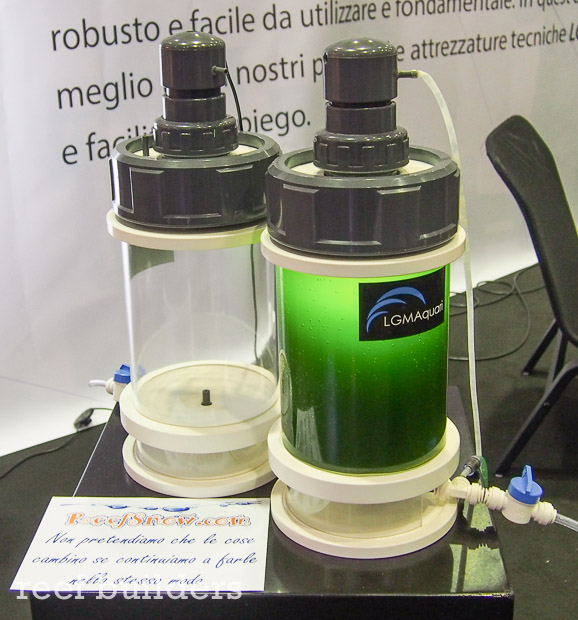The aquarium phytoplankton reactor is a product whose existence is known about in North America, but nowhere have we seen it more exalted than in Italy where countless manufacturers offer a myriad of ways to grow liquid salad for our reef tanks. While at PetsFestival in Italy we got to spend some time with LGM Aquari’s take on the phytoplankton reactor concept.
Like everything else they build, we could have played soccer with this acrylic behemoth on the pavement of the event floor with likely more damage to our feet than the actual device. Many phytoplankton reactor, like the AquaMedic PhytoReactor, have aimed for long and skinny culture tubes that pair up nicely with the long skinny fluorescent tubes used to light them. However with the advent of more powerful and affordable LED lighting options, LGM Aquari developed a unique way to design a phytoplankton reactor.
 LGM Aquari’s signature heavy duty acrylic and lathed PVC parts are what make up their phytoplankton reactor and of course there are the requisite ports for airline for aeration, air vent and dosing of the actual phytoplankton solution. One particularly neat aspect of building a shorter, and wider diameter phytoplankton reactor is the ability to use solid plumbing union fittings for getting into the reactor for cleaning and servicing – no wingnuts or keyhole flanges to fiddle with, just one big locking union to seal up the whole thing.
LGM Aquari’s signature heavy duty acrylic and lathed PVC parts are what make up their phytoplankton reactor and of course there are the requisite ports for airline for aeration, air vent and dosing of the actual phytoplankton solution. One particularly neat aspect of building a shorter, and wider diameter phytoplankton reactor is the ability to use solid plumbing union fittings for getting into the reactor for cleaning and servicing – no wingnuts or keyhole flanges to fiddle with, just one big locking union to seal up the whole thing.
 Better yet, instead of using a large, inefficient T5 tube that needs to be replaced periodically as its output decreases, the LGM Aquari reactor uses a short and affordable LED spotlight. The spotlight’s lenses are strong enough to penetrate through a few inches of a thick phytoplankton solution but to combat this problem, LGM Aquari developed a special ‘fiber optic’ lens which is basically a frosted acrylic cylinder which carries the light deep down into the phytoplankton culture.
Better yet, instead of using a large, inefficient T5 tube that needs to be replaced periodically as its output decreases, the LGM Aquari reactor uses a short and affordable LED spotlight. The spotlight’s lenses are strong enough to penetrate through a few inches of a thick phytoplankton solution but to combat this problem, LGM Aquari developed a special ‘fiber optic’ lens which is basically a frosted acrylic cylinder which carries the light deep down into the phytoplankton culture.
Phytoplankton reactors are a niche piece of aquarium equipment, but they are really being celebrated in Italy like nowhere else we have seen and LGM Aquari’s robust take on the concept seems like one of the more creative designs around. [LGM Aquari]






